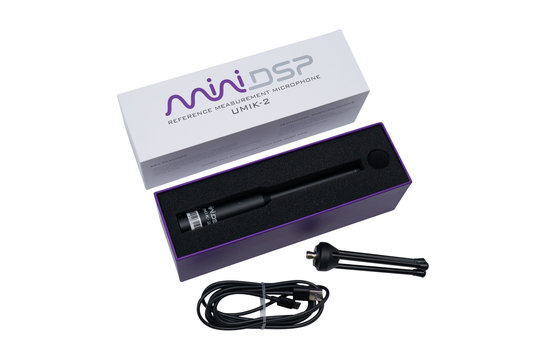Reference measurement microphone with low noise floor, 32-bit ADC with selectable sample rate and unique calibration file.
Are you interested in measurement microphones? Find out everything you need to know in our comprehensive blog and find the perfect measurement microphone for your needs.
Highlights of the miniDSP UMIK-2
- Suitable for reference applications
- Unique calibration file for each microphone
- 1/2" capsule detachable through 60 UNS thread
- ADC with 32-bit resolution and selectable sample rate between 44.1 and 192 kHz
- Custom Windows ASIO drivers and Plug&Play on Linux/Mac OS X
- Low noise floor preamps, 120DR ADC
- Plug&Play compatibility with REW & Dirac Live
Product details miniDSP UMIK-2
miniDSP UMIK-2 USB Reference Measurement Microphone
The miniDSP UMIK-2 is a high performance measurement microphone from our test and measurement category. The UMIK-2 is developed by miniDSP as improvement on the popular UMIK-1, one of SoundImports's best selling products.
The UMIK-2 is equipped with a large 13mm microphone capsule for a reduced noise floor and improved distortion performance. The microphone is powered through USB-C and has driverless support on OS X and Linux. MiniDSP developed a custom ASIO driver for easy integration with Microsoft Windows.
The inbuilt ADC, with a 32-bit resolution, converts the measured signal while retaining high quality. The UMIK-2 is recommended by REW (Room Equalisation Wizard) and DiracLive (V3.x and later) for the highest measurement accuracy. The selectable sample rate (44.1 to 192 kHz) allows for easy integration with most other measurement and recording software.
What's included with this product?
- 1 x UMIK-2 microphone
- 1 x shielded USB type C cable (2m)
- 1 x Mini Tripod + Mic Clamp
- 1 x windscreen
Unique Calibration File Download
Each UMIK-2 has an unique calibration file. You can download this calibration file from miniDSP with the serial number from your device.
FAQ about the miniDSP UMIK-2
What are the main differences between the UMIK-1 and the UMIK-2?
The UMIK-2 is improved on analog, digital and functional aspects compared the UMIK-1. The larger capsule enables better noise and distortion performance. The improved analog performance is preserved by the high quality ADC. The new USB interface allows for easy software controllable settings, such as gain control and sample rate selection.
There are two different calibration files available for download, which one should I use?
For measuring a single speaker or a stereo pair, you use the ‘0deg’ calibration file. The capsule should be pointed at the speakers. For measuring a surround system or multichannel application, you use the 90deg calibration file. The capsule should be pointed at the ceiling
What software should I use for measurements?
We recommend Room EQ Wizard (REW). This free room acoustics analysis software is perfect for measuring and analyzing room and loudspeaker responses. However, you can use any software that accepts a calibration file. Other examples are: ARTA, Smaart, Fuzzmeasure, and HolmImpulse
Can I use the UMIK-2 to measure impedance curves or acquire T/S parameters?
The UMIK-2 measures an acoustic signal. Therefore you cannot use the UMIK-2 for T/S parameters or impedance measurements. The Dayton Audio DATS V3 is a perfect companion for acquiring T/S parameters. The Audiomatica CLIO Pocket 2.1 is a great alternative, that combines both acoustic and electrical signal measurements into one package.











 Home audio
Home audio  Audio components
Audio components  Crossover components
Crossover components  Test & measurement
Test & measurement  DIY kits
DIY kits  Accessories
Accessories  New products
New products  Speakers
Speakers Amplifiers
Amplifiers DAC converters
DAC converters DSP modules
DSP modules Turntables
Turntables Streamers
Streamers Woofers
Woofers Tweeters
Tweeters Exciters
Exciters Bass shakers
Bass shakers Plate amplifiers
Plate amplifiers Amplifier modules
Amplifier modules Single board computers
Single board computers Assembled crossovers
Assembled crossovers Printed Circuit Boards (PCB)
Printed Circuit Boards (PCB) Capacitors
Capacitors Resistors
Resistors Coils
Coils Circuit Breakers
Circuit Breakers Crossover tools
Crossover tools Screw terminals
Screw terminals Acoustic measurements
Acoustic measurements Electric measurements
Electric measurements Sound level meters
Sound level meters DIY amplifier kits
DIY amplifier kits DIY component packs
DIY component packs DIY speaker kit
DIY speaker kit DIY subwoofer kits
DIY subwoofer kits DIY bluetooth speaker
DIY bluetooth speaker DIY electronics kits
DIY electronics kits Binding posts
Binding posts Cabinet Hardware
Cabinet Hardware Cables
Cables Connectors
Connectors Speaker cabinets
Speaker cabinets Electromechanics
Electromechanics Power supplies
Power supplies Speaker repair
Speaker repair Workshop & tools
Workshop & tools Amplifier accessories
Amplifier accessories Stands & mounts
Stands & mounts Gift voucher
Gift voucher Books
Books New products
New products









 Speakers
Speakers Amplifiers
Amplifiers DAC converters
DAC converters DSP modules
DSP modules Turntables
Turntables Streamers
Streamers Woofers
Woofers Tweeters
Tweeters Exciters
Exciters Bass shakers
Bass shakers Plate amplifiers
Plate amplifiers Amplifier modules
Amplifier modules Single board computers
Single board computers Assembled crossovers
Assembled crossovers Printed Circuit Boards (PCB)
Printed Circuit Boards (PCB) Capacitors
Capacitors Resistors
Resistors Coils
Coils Circuit Breakers
Circuit Breakers Crossover tools
Crossover tools Screw terminals
Screw terminals Acoustic measurements
Acoustic measurements Electric measurements
Electric measurements Sound level meters
Sound level meters DIY amplifier kits
DIY amplifier kits DIY component packs
DIY component packs DIY speaker kit
DIY speaker kit DIY subwoofer kits
DIY subwoofer kits DIY bluetooth speaker
DIY bluetooth speaker DIY electronics kits
DIY electronics kits Binding posts
Binding posts Cabinet Hardware
Cabinet Hardware Cables
Cables Connectors
Connectors Speaker cabinets
Speaker cabinets Electromechanics
Electromechanics Power supplies
Power supplies Speaker repair
Speaker repair Workshop & tools
Workshop & tools Amplifier accessories
Amplifier accessories Stands & mounts
Stands & mounts Gift voucher
Gift voucher Books
Books New products
New products



























